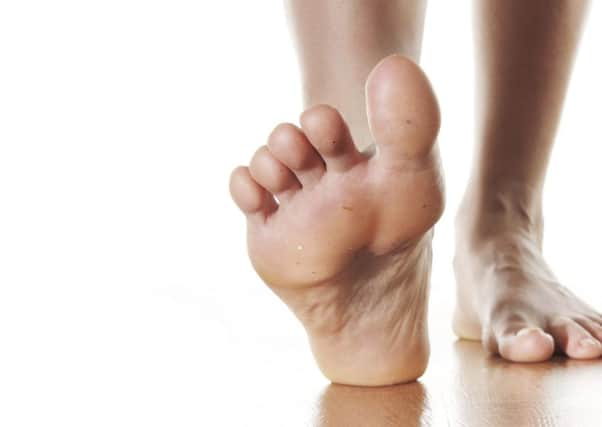Your Health: Treat your feet this summertime


The warm weather creates a breeding ground for fungi to grow, increasing your risk of foot infections and regular use of sandals and flip flops dries your feet out.
Add to this that our feet are on show much more than usual and this causes the embarrassment and discomfort of the two most common foot problems experienced by the general population.
Advertisement
Hide AdAdvertisement
Hide AdOne of the most frequent foot problems experienced throughout the summer months are cracked heels. In the world of medical jargon, these are known as heel fissures.
Wearing open-back shoes such as flip-flops or sandals forces the fat pad under the heel to spread out sideways, which increases the pressure on the skin to crack.
Imagine the heel to be like a tomato! In the warm, dry weather, pressure on a tomato would force it to split in a similar fashion. Dry and/or hard skin around the heel and standing for prolonged periods of time will further contribute to the cracking.
Heel fissures can be unsightly and for some, if left untreated can become deep, bleed and cause pain when walking. It is essential that people with diabetes check their feet daily for heel fissures, as they can be prone to further problems associated with cracked heels including infection and a delay in their healing.
Advertisement
Hide AdAdvertisement
Hide AdApplying a moisturising cream twice a day can help keep the skin supple and hydrated allowing the skin to heal and prevent further cracking. Any cream is better than none, however if your feet are particularly dry try using a cream containing urea (10 per cent) or salicylic acid (0.5-3 per cent). You can seek further advice from your local pharmacist or podiatrist regarding the most appropriate moisturiser or emollient.
To reduce any hard skin around the heel a pumice stone or foot file should be used before applying cream. Do not attempt to remove the hard skin with a razor blade or another sharp object as this could damage the healthy tissue and lead to infection. Professional removal by a podiatrist is recommended if the hard skin cannot be self-controlled and the problem is worsening.
The likelihood of developing fungal infections over the summer months is increased since a fungus thrives in warm moist environments. The most common fungal skin infection is athletes’ foot. The causes include, walking barefoot in communal areas, sweaty feet, a low immune system, poor foot hygiene and wearing tight restricting shoes that do not allow adequate ventilation.
Athletes’ foot affects people in different ways depending on the type of fungus, the location and severity of the infection.
Advertisement
Hide AdAdvertisement
Hide AdSymptoms include itchiness, redness, blistering and flaky skin. It may spread to other areas of the foot including toenails, whereby the nails can become discoloured, yellow and brittle.
Various treatments are available over the counter which are applied to the skin to kill the fungus and prevent it from multiplying.
Powders and sprays are usually more beneficial for those infections located between the toes. Incomparison cream preparations are best used when the infection has caused dry cracked skin, typically located around the rim of the foot.